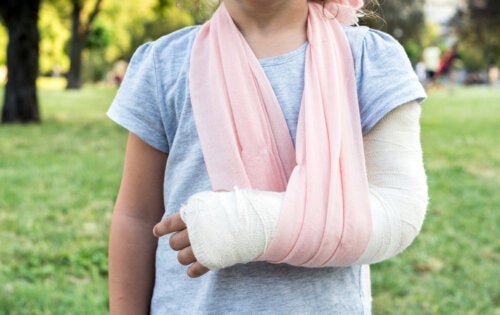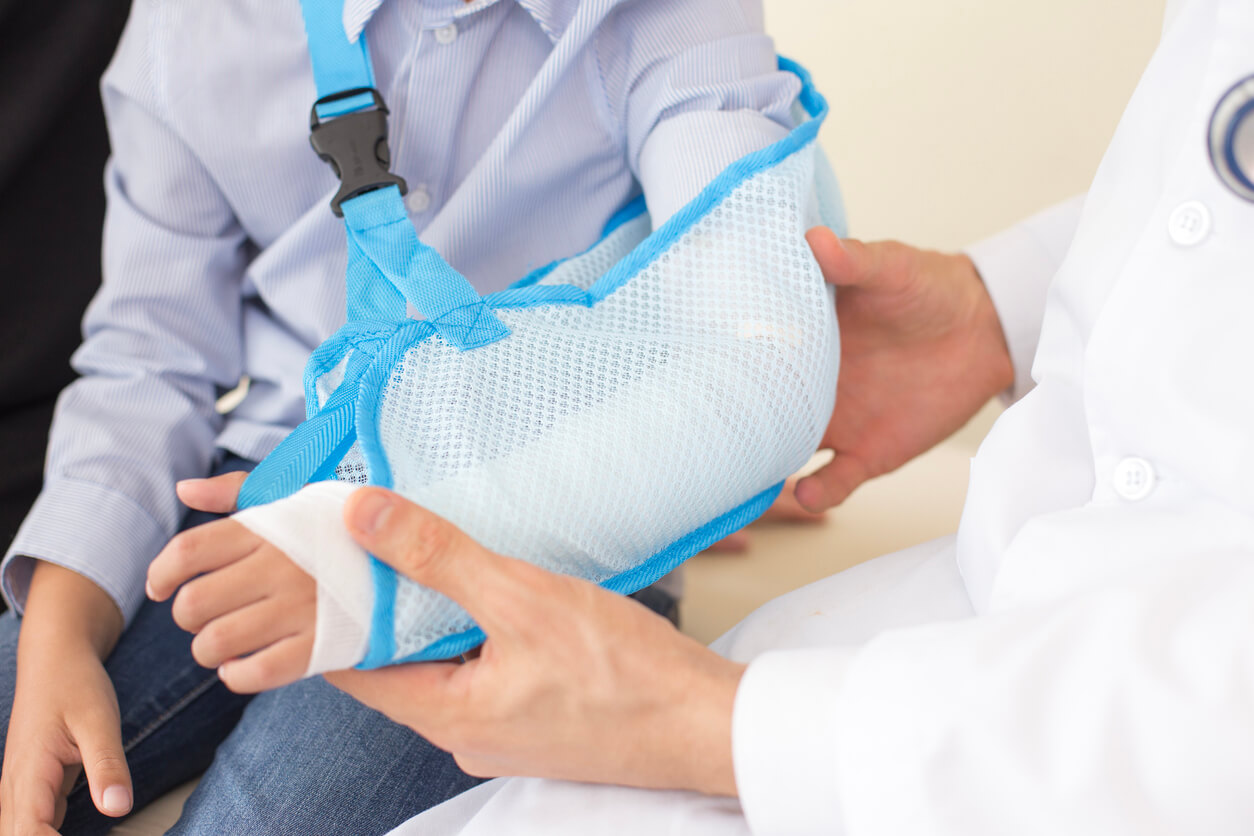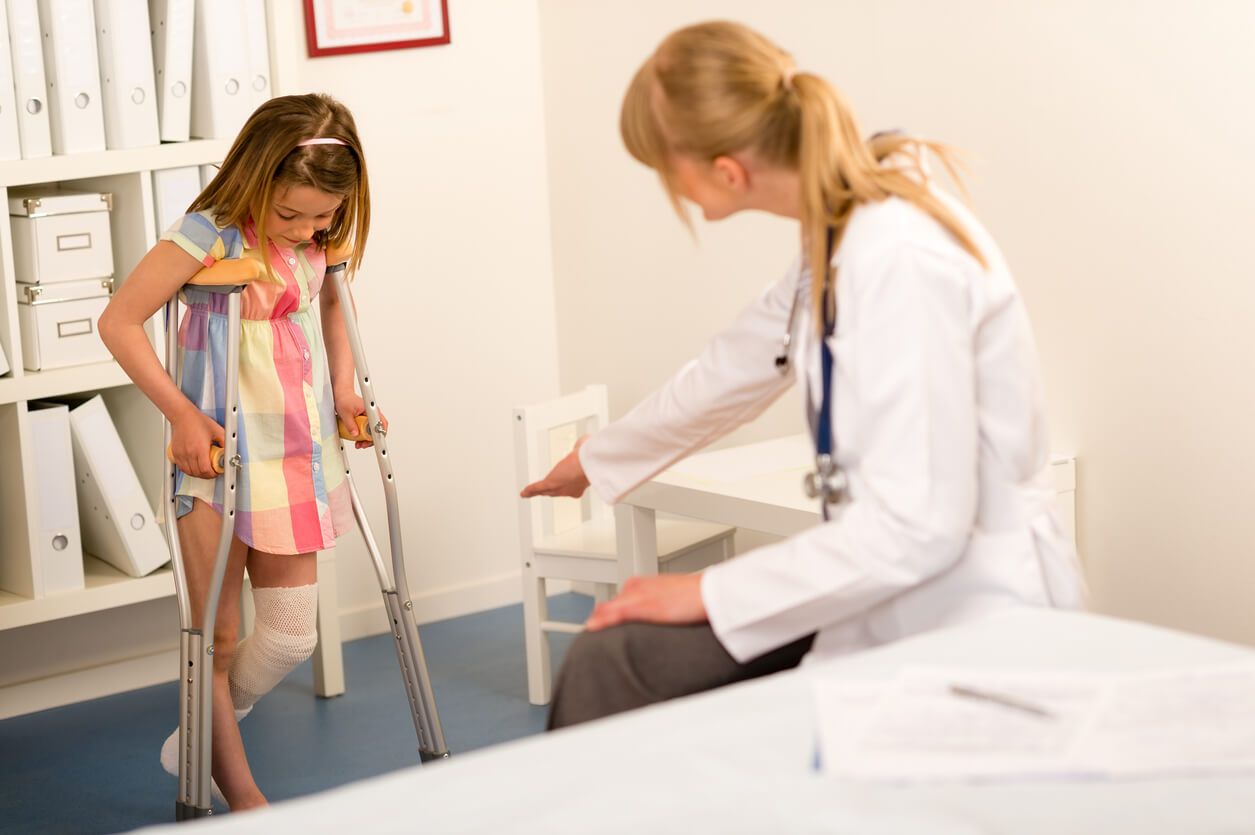The 7 Most Frequent Fractures in Children


Written and verified by the physiotherapist Maria Elisa Lisotti Luppi
Children’s bones have different characteristics from those of adults. They’re stronger and more elastic, they have growth cartilage, and their tissue is more active. All this means that in the event of an injury, their recovery is faster and requires less immobilization time. Nevertheless, fractures in children are very frequent.
This is mainly due to the restless nature of children. Falls during play are one of the main causes of this type of bone injury, and the way they fall has a great influence on the affected bone. Here are the most common childhood fractures and their causes.
1. Clavicle fracture
Clavicle fractures occur due to falls on the shoulder and are more common in boys. In young children, there’s usually no displacement of the fractured fragments, while in adolescents, this is a fairly common occurrence.
The frequency of occurrence in infants is low but may occur during childbirth. Despite the inconvenience of this situation, in general, this fracture has a very good evolution. When a high-impact trauma occurs, such as a fall while practicing a sport, a fracture may occur. Immediately, the child will present pain and localized swelling.
This type of fracture is manifested with decreased mobility of the affected arm, and a doctor can confirm it through a simple X-ray.
The treatment isn’t usually surgical unless it’s an exposed, bilateral, or more complex fracture. Immobilization is done with a sling that helps to rest the weight of the arm. In some cases, an 8 bandage will suffice. After 3 to 4 weeks, it’s removed, and rehabilitation with physiotherapy is indicated.
2. Elbow fracture
Childhood elbow fractures, as well as clavicle fractures, are more frequent in male children. They occur most frequently between 5 and 10 years of age. The most common cause is a fall on the palm of the hand with the arm extended.
A child with an elbow fracture will have pain, swelling, and difficulty moving the affected limb. In some cases, there’ll also be bruising in the injured area.
Since it’s an area that’s so close to the joint, surgical treatment will often be necessary to correct the alignment of the fractured lines and avoid future sequelae.
After surgery or immobilization, rehabilitation with physiotherapy will be indicated. The aim of this is to recover the full range of mobility of the joint, as well as the muscle strength of the entire affected limb.

3. Forearm fracture
Fractures of the forearm in children can also be associated with elbow or wrist fractures, depending on the trauma that produced the fracture. The most frequent fractures occur near the wrist, that is, at the distal end of the forearm, and consist of 3 types:
- Fracture with deformity: The bone is fractured inside, but the edges remain continuous.
- Greenstick fracture: The bone is curved on one side and broken on the other. They’re the most frequent in young children.
- Complete fracture: The bone breaks from side to side. They usually occur in children older than eight years old.
As with clavicle fractures, after they occur, children will have pain, swelling, and decreased mobility of the joint.
The treatment of these fractures is variable, depending on the severity of the fracture and the age of the child. The mildest may require immobilization with a cast for 4 to 6 weeks. Still, in some cases, aligning the bones in the operating room under anesthesia is required before immobilization.
4. Ankle fracture
This type of fracture is very common, usually occurring as a result of direct trauma to the foot. When a child fractures the ankle, it’s usually swollen, misaligned, and bruised.
The deformity of the affected area will depend on the severity of the fracture and whether it’s displaced or not. When trying to mobilize the foot or put weight on it, the child will report pain.
For tibia or fibula fractures without displacement, the treatment consists of immobilizing the joint for 3 to 4 weeks and avoiding weight bearing. In cases of fractures with displacement or more severe cases, aligning the bones in the operating room under anesthesia will be necessary.
5. Metatarsal fracture
The metatarsals are five long bones located in the midfoot. They connect the ankle to the toes. Fractures of any of these bones are common in children and usually occur as a result of direct trauma during a sports activity. These fractures are rarely displaced.
The treatment consists of immobilizing the foot for four weeks. The child will be able to walk some on the affected foot as long as the pain allows it.

6. Femur fractures
The femur is one of the most commonly fractured bones in the body; the solution of continuity can occur in the proximal, middle, or distal third of the bone. In children, fractures of the middle third or diaphyseal femur are very common. They can occur by different mechanisms involving high and low energy.
Fortunately, this bone doesn’t usually have problems with healing, as it’s a very well-irrigated area. Treatment is typically conservative in most cases, although everything will depend on the type of fracture and the extent of the bone injury. The cast that’s used in these cases usually goes from the pelvis to the ankles, and the duration of the cast is very variable.
Fractures in the distal portion of the bone are usually more serious, although less frequent in childhood. They’re associated with lesions in the growth plate or the joint, so their management is more delicate.
7. Tibial fractures
The tibia is the bone of the body that supports more weight. In addition, it’s exposed in its anterior and distal parts, so it’s very prone to fracture. In this regard, diaphyseal fractures of the tibia are very common in children and, unfortunately, tend to be open in many cases.
The mechanisms of production are usually direct trauma, although falls can also cause them. The types of fractures observed are also very varied, as they can range from a linear fracture to a comminuted fracture, i.e., with multiple fragments.
Treatment is typically conservative in most cases, and an orthopedic boot, which goes from 3 fingers below the knee to the toes, is used. Surgical treatment is reserved for open fractures and for those cases in which there’s severe instability.
About fractures in children
As we’ve seen in this article, the most frequent infant fractures occur in their extremities. This is directly related to the frequent blows and falls typical of their age. Many times, they occur during play or in the context of household accidents. Although treatments will depend on the type of fracture, physiotherapy is recommended in all cases.
After the period of immobilization is over, or surgery in the most severe cases, physiotherapy will be a fundamental tool to reduce the risk of further complications. Although children usually recover very well, this practice helps to reduce pain, increase active mobility, and improve muscle strength in the affected area.
Children’s bones have different characteristics from those of adults. They’re stronger and more elastic, they have growth cartilage, and their tissue is more active. All this means that in the event of an injury, their recovery is faster and requires less immobilization time. Nevertheless, fractures in children are very frequent.
This is mainly due to the restless nature of children. Falls during play are one of the main causes of this type of bone injury, and the way they fall has a great influence on the affected bone. Here are the most common childhood fractures and their causes.
1. Clavicle fracture
Clavicle fractures occur due to falls on the shoulder and are more common in boys. In young children, there’s usually no displacement of the fractured fragments, while in adolescents, this is a fairly common occurrence.
The frequency of occurrence in infants is low but may occur during childbirth. Despite the inconvenience of this situation, in general, this fracture has a very good evolution. When a high-impact trauma occurs, such as a fall while practicing a sport, a fracture may occur. Immediately, the child will present pain and localized swelling.
This type of fracture is manifested with decreased mobility of the affected arm, and a doctor can confirm it through a simple X-ray.
The treatment isn’t usually surgical unless it’s an exposed, bilateral, or more complex fracture. Immobilization is done with a sling that helps to rest the weight of the arm. In some cases, an 8 bandage will suffice. After 3 to 4 weeks, it’s removed, and rehabilitation with physiotherapy is indicated.
2. Elbow fracture
Childhood elbow fractures, as well as clavicle fractures, are more frequent in male children. They occur most frequently between 5 and 10 years of age. The most common cause is a fall on the palm of the hand with the arm extended.
A child with an elbow fracture will have pain, swelling, and difficulty moving the affected limb. In some cases, there’ll also be bruising in the injured area.
Since it’s an area that’s so close to the joint, surgical treatment will often be necessary to correct the alignment of the fractured lines and avoid future sequelae.
After surgery or immobilization, rehabilitation with physiotherapy will be indicated. The aim of this is to recover the full range of mobility of the joint, as well as the muscle strength of the entire affected limb.

3. Forearm fracture
Fractures of the forearm in children can also be associated with elbow or wrist fractures, depending on the trauma that produced the fracture. The most frequent fractures occur near the wrist, that is, at the distal end of the forearm, and consist of 3 types:
- Fracture with deformity: The bone is fractured inside, but the edges remain continuous.
- Greenstick fracture: The bone is curved on one side and broken on the other. They’re the most frequent in young children.
- Complete fracture: The bone breaks from side to side. They usually occur in children older than eight years old.
As with clavicle fractures, after they occur, children will have pain, swelling, and decreased mobility of the joint.
The treatment of these fractures is variable, depending on the severity of the fracture and the age of the child. The mildest may require immobilization with a cast for 4 to 6 weeks. Still, in some cases, aligning the bones in the operating room under anesthesia is required before immobilization.
4. Ankle fracture
This type of fracture is very common, usually occurring as a result of direct trauma to the foot. When a child fractures the ankle, it’s usually swollen, misaligned, and bruised.
The deformity of the affected area will depend on the severity of the fracture and whether it’s displaced or not. When trying to mobilize the foot or put weight on it, the child will report pain.
For tibia or fibula fractures without displacement, the treatment consists of immobilizing the joint for 3 to 4 weeks and avoiding weight bearing. In cases of fractures with displacement or more severe cases, aligning the bones in the operating room under anesthesia will be necessary.
5. Metatarsal fracture
The metatarsals are five long bones located in the midfoot. They connect the ankle to the toes. Fractures of any of these bones are common in children and usually occur as a result of direct trauma during a sports activity. These fractures are rarely displaced.
The treatment consists of immobilizing the foot for four weeks. The child will be able to walk some on the affected foot as long as the pain allows it.

6. Femur fractures
The femur is one of the most commonly fractured bones in the body; the solution of continuity can occur in the proximal, middle, or distal third of the bone. In children, fractures of the middle third or diaphyseal femur are very common. They can occur by different mechanisms involving high and low energy.
Fortunately, this bone doesn’t usually have problems with healing, as it’s a very well-irrigated area. Treatment is typically conservative in most cases, although everything will depend on the type of fracture and the extent of the bone injury. The cast that’s used in these cases usually goes from the pelvis to the ankles, and the duration of the cast is very variable.
Fractures in the distal portion of the bone are usually more serious, although less frequent in childhood. They’re associated with lesions in the growth plate or the joint, so their management is more delicate.
7. Tibial fractures
The tibia is the bone of the body that supports more weight. In addition, it’s exposed in its anterior and distal parts, so it’s very prone to fracture. In this regard, diaphyseal fractures of the tibia are very common in children and, unfortunately, tend to be open in many cases.
The mechanisms of production are usually direct trauma, although falls can also cause them. The types of fractures observed are also very varied, as they can range from a linear fracture to a comminuted fracture, i.e., with multiple fragments.
Treatment is typically conservative in most cases, and an orthopedic boot, which goes from 3 fingers below the knee to the toes, is used. Surgical treatment is reserved for open fractures and for those cases in which there’s severe instability.
About fractures in children
As we’ve seen in this article, the most frequent infant fractures occur in their extremities. This is directly related to the frequent blows and falls typical of their age. Many times, they occur during play or in the context of household accidents. Although treatments will depend on the type of fracture, physiotherapy is recommended in all cases.
After the period of immobilization is over, or surgery in the most severe cases, physiotherapy will be a fundamental tool to reduce the risk of further complications. Although children usually recover very well, this practice helps to reduce pain, increase active mobility, and improve muscle strength in the affected area.
All cited sources were thoroughly reviewed by our team to ensure their quality, reliability, currency, and validity. The bibliography of this article was considered reliable and of academic or scientific accuracy.
- Olsen B, Gonzalez G. Urgencias en traumatología: fracturas frecuentes en niños. Anales de Pediatría Continuada. Jun 2009 [Internet]. Vol. 7. Núm. 3. páginas 177-181. DOI: 10.1016/S1696-2818(09)71124-2. Disponible en: https://www.elsevier.es/es-revista-anales-pediatria-continuada-51-pdf-S1696281809711242 (Acceso Jun 2021)
- Olmedo, J. López. Fracturas infantiles más frecuentes. Esguinces y epifisiolisis. PediatríaIntegral 221 (2019): 222.
- González Herranz P, Castro Torre M, de los Llanos Rodríguez M, Penelas N. Epifisiolisis y fracturas en los niños. En: Gomez Barrena E y Cordero Ampuero J. Traumatología Y Ortopedia: Generalidades. Elsevier España. Año 2020.
- Muñoz, Rosa Elena Ambi, et al. Complicaciones post operatorias en niños intervenidos por fractura de cadera. RECIMUNDO 4.2 (2020): 142-151.
- Martínez-Cano, Juan Pablo, et al. Fracturas en niños: experiencia en un centro de alta complejidad del suroccidente Colombiano. Revista de la Universidad Industrial de Santander. Salud 51.4 (2019): 309-315.
- Aguilella Fernández, Luis, B. Maruenda García Peñuela, and Lucía García Martínez. Corrección de deformidad postraumática del radio distal secundaria a puente óseo fisario. Revista española de cirugía osteoarticular, 2017, vol. 51, no. 268. p 172-176
- Acosta Ali, Delfin Antonio. Factores ginecobstetricos y neonatales asociados a fractura de clavícula en neonatos en el hospital Honadomani Madre–Niño San Bartolomé en el año 2016–febrero 2019. Universidad Ricardo Palma. Lima, Perú. Año 2020. Disponible en: https://repositorio.urp.edu.pe/bitstream/handle/URP/3158/T030_70578215_T%20%20%20ACOSTA%20ALI%20DELFIN%20ANTONIO.pdf?sequence=1&isAllowed=y [Accesed jun 2021]
- Luis Felipe, Haro Moyón, and Coloma Armas Mauricio Javier. Fracturas mas frecuentes en el servicio de pediatria, Hospital Provincial General Docente Riobamba, 2018-2019. BS thesis. Universidad Nacional de Chimborazo. Ecuador. Año 2020. Disponible en: http://dspace.unach.edu.ec/handle/51000/6799 [Accesed jun 2021]
This text is provided for informational purposes only and does not replace consultation with a professional. If in doubt, consult your specialist.








